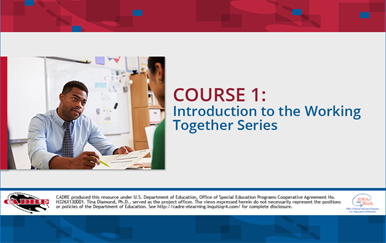Introduction
Dispute resolution systems must be culturally and linguistically competent to meet the interests and needs of diverse populations residing in the United States, territories, and tribal nations.

This self-assessment tool can be useful in determining the level of cultural and linguistic competence in a dispute resolution system.
Culturally and linguistically competent systems are aware of barriers, biases, and disparities that exist within their system, and which lead to inequitable outcomes for users. Culturally and linguistically competent systems prioritize reducing barriers, biases, and disparities by engaging with multiple stakeholders within diverse communities, challenging norms and assumptions, and embracing varied ideas.
Why is Self-assessment Important?
Taking a critical look at a dispute resolution system using CADRE's cultural and linguistic competence assessment tool can help states examine their capacity to effectively serve the interests of all those engaged in dispute resolution. A self-assessment can provide a baseline to identifying a state dispute resolution system’s strengths and opportunities for growth in relation to cultural and linguistic competence.
CADRE promotes a strengths-based approach to the self-assessment and system improvement process, encouraging teams to leverage their existing assets to advance cultural and linguistic competence. By engaging in a self-assessment process, teams can develop a roadmap and timeline for activities to improve their system’s cultural and linguistic competency.
About the Assessment Tool
- This assessment tool is designed to be completed with a team to encourage diverse perspectives and robust discussion.
- The self-assessment process allows for important foundational steps to be taken before attempting larger systemic improvements.
- This assessment tool provides a clear understanding of the system’s current functioning so that a team can decide where to focus improvement efforts.
- The User Guide will help teams determine what goals to prioritize and what activities are needed to accomplish those goals.
Key Phases
Phase 1: Getting Started - Review the User Guide
CADRE recommends reviewing the complete User Guide as a team before beginning the assessment process. The User Guide includes the self-assessment tool, action planning template, glossary of terms, coaching questions, and sample group norms.
Phase 2: Complete the Self-assessment
CADRE recommends that the self-assessment tool be used in conjuction with the glossary of terms and coaching questions. Throughout the assessment tool, specfic terms are linked to definitions in the glossary. The coaching questions may be useful to help teams ensure a shared understanding of function areas and indicators within the tool.
Phase 3: Establish Priority Areas of Focus
Completing the self-assessment process gives the team a better understanding of the system’s strengths and challenges in serving all stakeholders. Completing the self-assessment should spur substantive changes. Consistent and intentional changes require establishing priority areas of focus. When determining priority areas of focus, consider needs, desired results, stakeholder and leadership interests, impact potential, opportunities, team's sphere of influence, time commitment, and constraints. Examining the team’s desired results is a good place to start. The following questions are designed to guide the team through this process.
- What is the team, including community stakeholders, hoping to accomplish overall? Why is it important to the system? To stakeholders?
- What will success look like at the system level? What observable changes will happen? What would success look like from the viewpoint of different stakeholders?
- How will improvements to the system likely impact stakeholder groups? Is there a particular community that warrants prioritization? Are there data that support a particular course of action?
- How will the team know if the work is having the intended impact? What data can be collected to determine success?
After establishing priority areas of focus and determining the desired results your team would like to accomplish, develop two or three impact statements as a team. For example, a team may decide it wants to intentionally engage a particular community to improve awareness and access of the DR system. The impact statement can be: “The [Name of SEA or LEA] will improve its relationship with the [community of choice] in order to increase parents’ understanding and access to early DR options.” Use your impact statements to guide improvement activities.
Phase 4: Action Planning
Action planning will provide a team with a roadmap to help reach its identified system changes. It will help team members and other stakeholders share the workload and responsibilities. The Action Planning Tool can be used to focus a team’s efforts by setting achievable goals and assigning responsibility among the group.
Recommended Supplemental Resources
- Expanded User Guide
- Sample Group Norms
- A Guide to Engaging Underserved Families in the CLC Assessment Process (Accessible version here)
- Equity and Cultural and Linguistic Competency Resources
- Data Meeting Toolkit (IDC Resource)
- Webinar - Gain a Better Understanding of Your Dispute Resolution System Utilizing CADRE’s CLC Self-assessment Process


